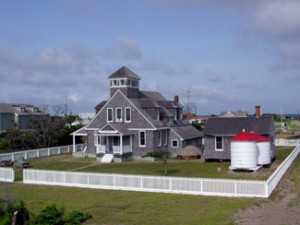Hatteras Island’s famous (sometimes infamous) NC Highway 12 is now part of the Outer Banks National Scenic Byway, designated in 2009 by the US Department of Transportation as the 150th and final highway in the nation to be so designated. Scenic Byways exist to “recognize, preserve and enhance the many cultural traditions of a distinctive region.” Our Byway includes sites on Bodie, Hatteras and Ocracoke Islands, as well as the communities along Core Sound and Back Sound, known as “Down East.” The Byway and its numerous historic and cultural sites are marked by colorful signs that depict water, shore, a boat and a lighthouse, all symbolic of the landscape and lifestyle of this beautiful part of North Carolina.
National Scenic Byway, designated in 2009 by the US Department of Transportation as the 150th and final highway in the nation to be so designated. Scenic Byways exist to “recognize, preserve and enhance the many cultural traditions of a distinctive region.” Our Byway includes sites on Bodie, Hatteras and Ocracoke Islands, as well as the communities along Core Sound and Back Sound, known as “Down East.” The Byway and its numerous historic and cultural sites are marked by colorful signs that depict water, shore, a boat and a lighthouse, all symbolic of the landscape and lifestyle of this beautiful part of North Carolina.
Among the early stops on the Hatteras Island portion of the Scenic Byway is the notable Chicamacomico Life Saving Station complex, dating from 1874, on Highway 12 in Rodanthe. The complex is considered among the most completely restored United States Life Saving Stations in the nation. It features the original 1874 station and its successor, the 1911 station, along with accessory buildings that display the difficult and rustic conditions endured by the men who served in the United States Life Saving Service. In 1915 the Service merged with its predecessor, the U.S. Revenue Cutter Service, and became the U. S. Coast Guard.
On my recent visit to Chicamacomico, a site defined by a romantic and adventurous history and modern day philanthropic historic preservation, I was greeted by a very knowledgeable tour guide and began my own adventure. The 1911 structure includes the Keeper’s/Captain’s Office and Quarters and an upper floor with Crew Quarters and Shipwreck Survivors Room, Superintendent’s Quarters, and a Watch Tower. (The second floor is currently under restoration and not open to the public.) This building also houses a gift shop and bookstore as well as a room for meetings and classes.
The 1874 Station occupies a site between the 1911 structure and the ocean, having been moved three times by the ocean and twice by man. The architecture is Carpenter Gothic, designed in the popular New England style by architect F.W. Chandler. It has been partially restored and contains a remarkable collection of artifacts associated with rescues from the sea. There is a surf boat, a life car (a container-like apparatus that survivors could be locked into and hauled through the waves to the beach), and the rescue beach cart and its ropes, block and tackle, shovels, sand anchors, and more. It is the actual surfboat used in the famous Mirlo rescue of 1918, the single most highly awarded maritime rescue in U.S. history. The British tanker Mirlo was torpedoed by a German U-boat in World War I, and the crew was rescued from the flaming tanker by the stalwart men of Chicamacomico.
Also part of the Chicamacomico complex is the 1907 Midgett House, originally owned by Cornelius Payne Midgett, the brother of Keeper John Allen Midgett, Jr., and his wife Daisy. All household items are from either the family or the period and provide a look into the everyday life of a hardy “Banker.” The house was donated by Midgett’s descendants, moved to the site in 2005 and opened to the public in 2006.
The restoration and continuing operation of the Chicamacomico Life-Saving Station complex is due in large part to the civic pride, historical expertise and determined activism of the Chicamacomico Historical Association, Inc., (CHA) and the philanthropy of benefactors Mr. and Mrs. Walter Davis. In 1968 the buildings were bought by the local Civic Association that then gifted them to the CHA. The oceanfront land in Rodanthe which had been returned to the Midgett heirs was auctioned, purchased by the Davises and given to the CHA. As the pieces came together, the work of the volunteers began in full force. The life of the Station and this invaluable part of Outer Banks history is in their capable hands.
